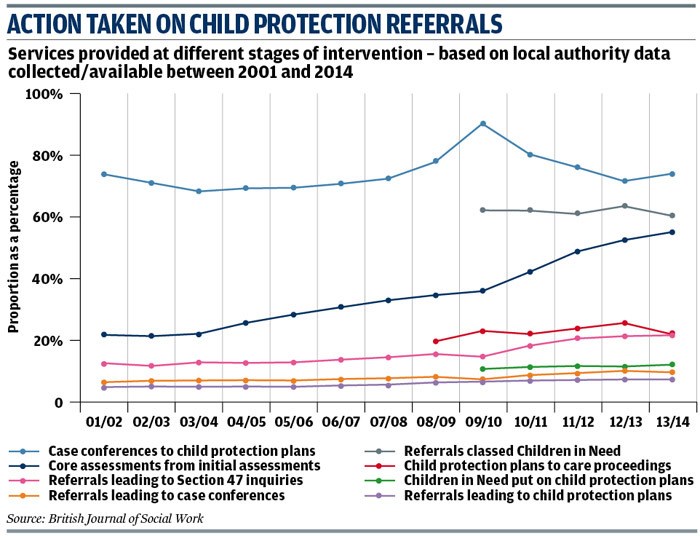Exploring Demand and Provision in English Child Protection Services
Charlotte Goddard
Monday, June 20, 2016
A team of researchers from Kingston University and the University of London wanted to map demand for, and provision of, services in the child protection system.
Authors Rick Hood, Allie Goldacre, Robert Grant and Ray Jones
Published by British Journal of Social Work, May 2016
SUMMARY
A team of researchers from Kingston University and the University of London wanted to map demand for, and provision of, services in the child protection system. They were interested in finding out how statutory agencies responded to fluctuations in demand, as well as how changes in demand can affect provision. In England, demand for child protection services comes in the form of referrals, with a series of thresholds designed to filter cases and ensure the right kind of provision for each.
The team used performance indicators from 2001 to 2014 for 152 local authorities to build a picture of the workings of the system as a whole. This included looking at data from the annual Children in Need census. Indicators included number of referrals, caseloads, social work vacancies and number of child protection conferences.
The data showed local authorities are increasingly using child protection interventions, a trend which accelerated in the wake of the "Baby P" case and subsequent inquiries in 2008/09. Referrals to child protection services remained steady between 2001 and 2005, declined gradually over the next four years and then rose sharply in 2009/10 and again in 2013/14. The statistics around provision showed ever-increasing rates of intervention with the use of child protection plans and Section 47 inquiries - which enable councils to decide whether they need to take further action to ensure a child's safety and wellbeing - almost doubling over the research period. The years after 2008/09 showed a particular increase. The researchers found the proportion of initial assessments that went on to be the subject of a more comprehensive core assessment almost doubled over this period.

The report authors found local authorities in more deprived areas experienced higher levels of demand and provided a different sort of service than those in more affluent areas. Higher rates of referrals were associated not only with a rise in activity in general, such as more assessments and plans, but also with specific kinds of decisions on referrals. Councils with higher rates were more likely to assess referrals as not requiring children in need services, to take no further action and to step down from statutory involvement earlier. The more referrals that came in, the less likely each referral was to be assessed.
Higher-demand local authorities tended to screen out more referrals and divert cases to non-statutory services. They also had a greater tendency to step down statutory plans quickly and were less likely to do long-term work with families. These councils also experienced higher rates of re-referrals - work coming back into the system within 12 months of a case being closed.
The researchers found spending on children's safety was higher in more deprived areas, but more of the demand was met by non-statutory services. In more affluent areas, spending on safeguarding was lower, but statutory services actually met more of the demand. Higher-demand local authorities tended to have higher caseloads and higher rates of agency workers.
Implications for practice
When external factors, such as an increase in deprivation, affect one part of the child protection system, other parts cannot easily adapt and the result is an increase in re-referrals, suggest the authors. While the Baby P crisis sparked a more interventionist approach to case management, the researchers say it merely fuelled a pre-existing trend. This created a step change in services that are unlikely to revert to previous rates of activity, they conclude. They also point out current indicators may not be serving the right purpose, with an emphasis on how councils manage demand in their areas rather than on how services are meeting the community's needs.
Further reading
- Child Welfare Inequalities: New Evidence, Further Questions, Paul Bywaters and others, Child & Family Social Work, May 2014. This reports the findings of a Nuffield Foundation-funded study examining the role of deprivation in explaining differences in children's services interventions between and within authorities.
- Rethinking Child Protection Strategy: Learning From Trends, Lauren Devine and Stephen Parker, University of the West of England, March 2015. A working paper analysing trends in child protection and safeguarding referrals, investigations and outcomes.
- Child Protection Systems: International Trends and Orientations, Neil Gilbert and others, Oxford University Press, June 2011. A comparative study of the policies and practices that frame society's response to child abuse in 10 countries including England.




